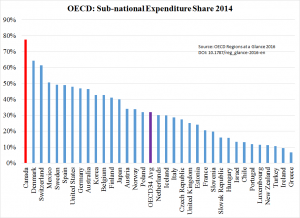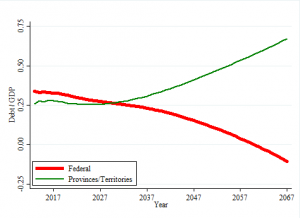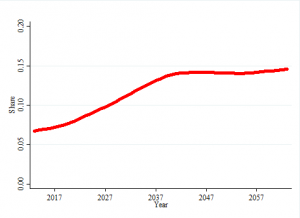Canada’s Radical Fiscal Federation
by kevinmil
Canada’s Radical Fiscal Federation
Kevin Milligan
UBC Vancouver School of Economics
Presentation at the conference “Canada at its Centennial and Sesquicentennial: transformative policy then and now” organized by UofT’s School of Public Policy and Governance, held in Toronto on November 17, 2017.
This is my draft script. The powerpoint slides can be downloaded here.
There will be a paper published in a book in 2018 based on this conference.
Introduction
We have created for ourselves a radically-decentralized fiscal federation. 78% of spending in Canada happens at subnational levels of government. In the US, it’s 48%. Across the OECD, the average is just 32%. We are a radical outlier.
How is it that we can maintain a modern welfare state mostly run by little provinces; some with only a few hundred thousand people? How can we raise the taxes to do so? Why are we so different? What forces shape our fiscal federation?
Is it our constitution? The constitution in 1867 gave much responsibility for unemployment relief, pensions, and schooling to provinces. That’s a starting place, but insufficient as an explanation. When economic forces demanded unemployment relief and pensions, we adjusted the constitution to allow it. The economic argument overran the constitutional status quo. So, it can’t be just constitutional forces leading to our decentralization.
Is it people? Is there a sense of national economic purpose sufficiently different in Canada that allows us to maintain this structure where other countries do not? A strong sense of national fairness and shared destiny could certainly contribute. You found some oil—share the gain. You lost your fish? Share the pain. Some Canadians feel this way. I’m sure not all do. Whatever the answer, I am skeptical we are such an outlier on national sentiments among the population to explain why we’re so different from other OECD countries.
What about fiscal accountability? Some argue that democratic transparency and accountability demands taxes be raised at the level of government that spends them. But we somehow get away with vast mismatches between spending and taxes at different levels of government. This likely does matter, but we seem to have succeeded in spite of stretching this mismatch substantially.
Economic Roots of Radical Decentralization
We have a radically decentralized federation. Constitutions, a populace with strong national purpose, and accountability are all important forces in a country. But in my view, it is economic efficiency—not fairness or constitutions—that underpins the radical decentralization of our fiscal federation. There are two elements.
The first is our system of intergovernmental transfers. They have constitutional origins, and are certainly held aloft by national sentiments. But to me the strongest argument for our transfer system is economic efficiency.
The scope and scale for efficient production of government-provided goods varies. For some goods, like education or parks, local or provincial governments can manage the spending efficiently. For others, like transportation or environment, a national or even global viewpoint is necessary to provide government services efficiently.
That’s the spending side. But the same is true as well for the efficiency of taxation, owing to the mobility or immobility of different tax bases. Sales and consumption taxes can vary across local jurisdictions without much economic cost, while at the other end, corporate and capital income is much more mobile and so might best be handled centrally.
Imagine if both taxes and spending are assigned to the optimal level of government. Economist Albert Breton noticed 50 years ago that it would be a great coincidence if optimal spending and tax assignment resulted in balanced budgets at each level of government. So, intergovernmental grants are required to maintain economic efficiency.
In other words, if we didn’t have a strong system of intergovernmental grants, either spending or taxation in Canada would be set inefficiently.
So, the efficiency of our system of intergovernmental grants is one big factor that allows us to have such a decentralized fiscal federation.
The second main factor is our system of tax collection agreements. For GST; for corporate and for personal taxes, most provinces allow the federal government to collect taxes on their behalf. The provinces have scope to choose rates and some degree of exemptions, but it is the federal government that does the actual collecting and the administration. Provinces just have to cash the cheques they receive from Ottawa.
This arrangement allows decentralized decisions about the level and type of taxes. It aligns spending with taxes to the degree possible, which bolsters fiscal clarity and accountability. It saves private taxpayers money by creating a national economic space with comparable rules and administration, rather than a balkanized system that is hard to comply with. Finally, it saves money by avoiding the replication of a separate tax administration apparatus in every province and territory.
So, my answer to why we have been able to radically decentralize the fiscal operations of our federation is that we have figured out economically efficient ways to do so. That’s where we are now, in the sesquicentennial year.
Trouble Ahead
Where will our fiscal federation be 50 years from now, in the bicentennial year? The Parliamentary Budget Officer produces an annual projection of fiscal sustainability for the federal and the provincial governments.
The chart shows the projected path of the debt/GDP ratio over the next fifty years. The federal government on its current trajectory will fully pay off its net debt by 2060. Program spending and transfers to children, the unemployed, and the elderly aren’t projected to be a long-run problem. Old age pensions for the boomers hit their peak in 2031 and decline thereafter. The feds are in a good position.
The provinces, on the other hand, are not. Debt is increasing starting in the mid-2020s and is on an explosive path. The reason is health spending.
There have been at least two decades of economists warning that health costs would rise substantially and some have noticed that dog hasn’t barked. The Canadian Institute for Health Information reports that the annual real increase over the five years from 2010-2014 was -0.2%.
Provinces have been innovating on the delivery of health services and working hard to limit health spending increases.
But, the problem is about to start accelerating. Health spending rises substantially at older ages—especially after age 75. The 75+ population share starts to rise in the 2020s and by the 2040s will be double the current share. These are demographic realities fixed into our population structure and unlikely to vary much. Provinces may be able to innovate their way through this, but they will need to step up the pace substantially in order to keep up with the pace of demographic change.
More likely, provincial budgets will be strained.
To get a sense of the magnitudes, take the case of British Columbia. The C.D. Howe Institute projects health spending will increase by 3 percentage points of GDP by 2030—just a few years from now. The kind of tax increase that would require is on the order of a doubling of either the provincial income tax or sales tax.
Radical solutions
But that’s the question: should provinces be left to handle this unprecedented increase in health spending on their own?
We could increase the existing Canada Health Transfer substantially to fund provincial health spending needs. This would require a sharp increase in federal taxation over the next two decades. The federal government, with its easier capacity to tax mobile personal and corporate income might be better placed to raise extra revenue fairly and efficiently. On the other hand, the transparency and accountability gap would grow as provinces spend more money they are not accountable for collecting.
A more radical solution is to “flip the table” on our current assignment of federal and provincial taxes. The federal government could relinquish four points of GST room to the provinces in exchange for provinces turning over all corporate income taxation to the federal government. This is approximately revenue neutral, but is arguably a more suitable assignment of taxing powers for several reasons.
- The sales tax base is not mobile, while the corporate tax base is the most mobile. The proposed move would therefore be more efficient.
- Central administration of the GST is efficient and nationally integrated.
- Personal taxes would continue to be split, allowing both the federal and provincial governments flexibility to adjust for fairness of the overall tax burden through the progressive income tax.
- Provinces would be raising their own revenue for their own spending needs, fulfilling demands for fiscal accountability.
The net result would give provinces primary control over a tax that can be used to fund future health needs that can be efficiently collected even when set differently across provinces.
Conclusion
Canada’s fiscal federation is radically decentralized from an international perspective. I argue here that the institutions that have evolved to facilitate this decentralization—intergovernmental transfers and centralized tax administration—are grounded in economic efficiency. The fiscal federation will face strong challenges in the next few decades as provincial health spending strains the existing arrangements, so radical solutions may need to be considered to maintain a stable decentralized federation.


